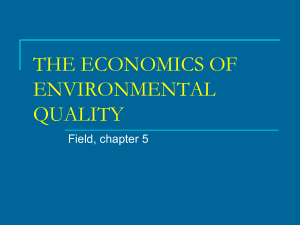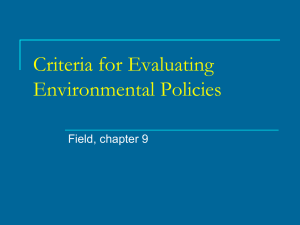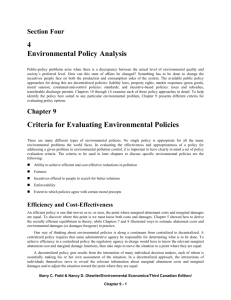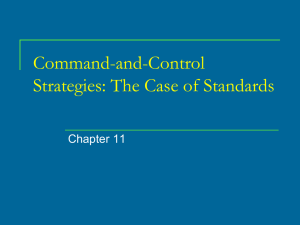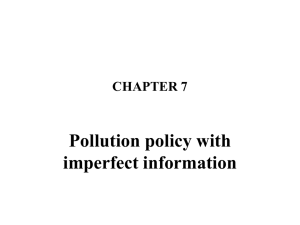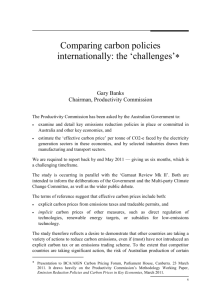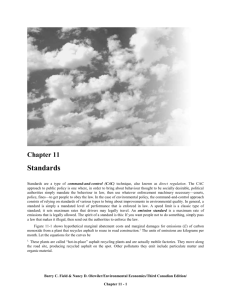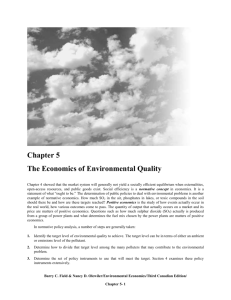Chapter 6 pictures
advertisement
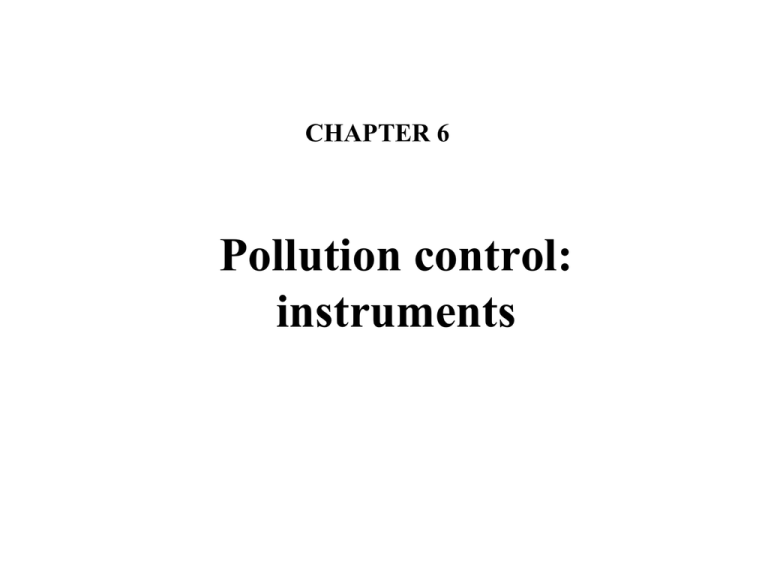
CHAPTER 6 Pollution control: instruments MC 200 MCB = 3ZB MCA = 3ZA 100 75 5 10 15 20 25 30 35 40 Z Pollution abatement, Z Figure 6.1 Marginal abatement cost functions for the two firms Figure 6.2 Expected damages, reducing as the amount of precaution taken, Q, increases Expected damages The amount of precaution taken, Q B(Q) C(Q) Figure 6.3 The socially efficient level of precautionary behaviour Q* The level of precaution applied is socially efficient when the net benefit (B – C) from precaution is maximised. This is shown at Q = Q*. Note that the slopes of the B and C functions are equalised at this point. Hence, as shown in the lower half of the graphic, the marginal quantities are equated. That is, the marginal benefit of precaution and the marginal cost of precaution are equal at the socially efficient level of precaution, Q*. That is, MB(Q*) = MC(Q*). Precaution, Q MC(Q) MB(Q) Q* Precaution, Q Ambient pollution levels Emissions output Quantity of goods produced Production technique Inputs used Figure 6.4a The pollution process Location of emissions Ambient pollution requirements Zoning Emissions licenses Output quotas Technology controls Input restrictions Figure 6.4b Command and control instruments Marginal damage Marginal benefit (before tax) * Marginal benefit (after tax) 0 M* ˆ M Emissions, M Figure 6.5 An economically efficient emissions tax Marginal cost of abatement * Marginal benefit of abatement 0 Z* = ˆ M* M Figure 6.6 The economically efficient level of emissions abatement Z Emissions abatement, Z Pre-tax or pre-subsidy marginal benefit μ~ 0 . Post-tax or post-subsidy marginal benefit . ~ M . ˆ M Emissions, M Figure 6.7 Emissions tax and abatement subsidy schemes when marginal damage is unknown, or when a target is being set on grounds other than economic efficiency Suppose that the EPA does not have sufficient information to deduce the economically efficient level of emissions, or it wishes to set an overall emissions target on some other basis. Figure 6.7 makes it clear that to attain ANY specific emissions target using a tax or subsidy instrument, knowledge of the aggregate (pre-tax or pre-subsidy) marginal benefit of emissions function would be sufficient. Pre-tax or pre-subsidy marginal benefit Marginal damage Post-tax or post-subsidy marginal benefit * 0 S3 S5 S4 S6 M* S2 S1 ˆ M Emissions, M Figure 6.8 Emissions tax and abatement subsidy schemes: a comparison An emissions tax and an emissions abatement subsidy (at the same rate) differ in terms of the distribution of gains and losses. This has important implications for the political acceptability and the political feasibility of the instruments. It also could affect the long-run level of pollution abatement under some circumstances, via alteration of the size of the industry. Marginal abatement cost (aggregate) Fixed supply of permits * 0 M* A firm will bid to purchase an additional emissions permit whenever the marginal cost of abating emissions exceeds the permit price. The market equilibrium permit price is determined by the value of the aggregate marginal abatement cost at the level of abatement implied by the total number of issued permits. ˆ M Figure 6.9 The determination of the market price of emissions permits Auctioned permits case Emissions, M Demand for permits Supply of permits * 0 EP* Emission permits (EP) Figure 6.10 The determination of the market price of emissions permits: free initial allocation case Marginal abatement cost Figure 6.11: Efficient abatement with two firms and marketable permits 200 180 MC(B) 160 140 Equilibrium permit price = Marginal abatement cost for each firm = 75 120 MC(A) 100 MC(INDUSTRY) 80 60 40 20 0 0 5 10 15 20 25 Emissions abatement, Z 30 35 40 45 50 Required industry wide abatement Under tradable permit schemes, in equilibrium marginal abatement costs will be equal over all firms. Hence marketable permits, like taxes and subsidies, achieve any given target at least cost. Moreover, if the total quantity of permits issued is M* and that quantity is identical to the level of emissions which would emerge from an emissions tax (or an abatement subsidy) at the rate * then a marketable permit scheme will generate an equilibrium permit price *. . Controlled sector . 2 1 . . 3 Firm 3, one of six controlled large power station sources of CO2 . 4 . 6 5 Figure 6.12.a A ‘cap and trade’ permit system Controlled sector . . 2 Firm 3, one of six controlled large power station sources of CO2 3 . 1 .. . A Uncontrolled sectors (of other CO2 emitters) . 4 . 5 C . A 6 . . D Figure 6.12.b A flexible permit system with offsets B Figure 6.13 Dynamic incentives under emissions tax controls £ MC1 MC2 0 Z1* Z2* Emissions abatement, Z Ci i • Ci αi βi M*i δi M*i2 M*i 0 • M*i ˆ M i Figure 6.14 The firm’s abatement cost function. M*i


